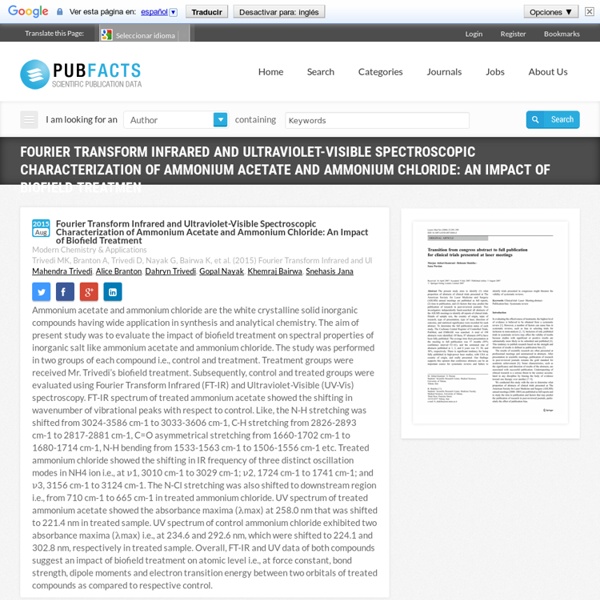



Characterization of Biofield Energy Treated Aluminium Carbide Aluminium carbide (Al4C3) has gained extensive attention due to its abrasive and creep resistance properties. Aim of the present study was to evaluate the impact of biofield treatment on physical and structural properties of Al4C3 powder. The Al4C3 powder was divided into two parts i.e. control and treated. Biofield | Antimycobacterial Susceptibility Potential The aim was to evaluate the impact of biofield treatment modality on mycobacterial strains in relation to antimycobacterials susceptibility. Mycobacterial sensitivity was analysed using 12 B BACTEC vials on the BACTEC 460 TB machine in 39 lab isolates (sputum samples) from stored stock cultures. Two American Type Culture Collection (ATCC) strains were also used to assess the minimum inhibitory concentration (MIC) of antimicrobials (Mycobacterium smegmatis 14468 and Mycobacterium tuberculosis 25177). Rifampicin, ethambutol and streptomycin in treated samples showed increased susceptibility as 3.33%, 3.33% and 400.6%, respectively, as compared to control in extensive drug resistance (XDR) strains. Pyrazinamide showed 300% susceptibility as compared to control in multidrug resistance (MDR) strains.
Influence of Human Biofield Treatment on Thymol and Menthol Thymol and menthol are naturally occurring plant derived compounds, which have excellent pharmaceutical and antimicrobial applications. The aim of this work was to evaluate the impact of biofield energy on physical and structural characteristics of thymol and menthol. The control and biofield treated compounds (thymol and menthol) were characterized by X-ray diffraction (XRD), Differential Scanning Calorimetry (DSC), Thermogravimetric analysis (TGA), and Fourier Transform Infrared Spectroscopy (FT-IR). XRD study revealed increase in intensity of the XRD peaks of treated thymol, which was correlated to high crystallinity of the treated sample.
Human Biofield Treated Disodium Hydrogen Orthophosphate and Sodium Nitrate Disodium hydrogen orthophosphate is a water soluble white powder widely used as pH regulator and saline laxative. The sodium nitrate is a highly water soluble white solid, used in high blood pressure, dentinal hypersensitivity, and production of fertilizers. The present study was aimed to investigate the impact of biofield treatment on spectral properties of disodium hydrogen orthophosphate and sodium nitrate. The study was performed in two groups i.e., control and treatment of each compound. The treatment groups were subjected to Mr. Trivedi’s biofield treatment. Characteristics of Klebsiella Oxytoca after Biofield Energy Treatment Klebsiella oxytoca (K. oxytoca) is a Gram-negative microbe generally associated with community and hospital- acquired infections. Due to its clinical significance, we evaluated the effect of biofield treatment on phenotype and biotype characteristics of K. oxytoca (ATCC 43165). The study was performed into three groups i.e. C (control), T1 (treatment, revived); and T2 (treatment, lyophilized). Subsequently, groups T1 and T2 were received biofield treatment and control group was remained as untreated.
Mahendra Trivedi's Biofield Treatment Impact on Klebsiella pneumoniae Klebsiella pneumoniae (K. pneumoniae) is a common nosocomial pathogen causing respiratory tract (pneumoniae) and blood stream infections. Multidrug-resistant (MDR) isolates of K. pneumoniae infections are difficult to treat in patients in health care settings. Aim of the present study was to determine the impact of Mr. Trivedi’s biofield treatment on four MDR clinical lab isolates (LS) of K. pneumoniae (LS 2, LS 6, LS 7, and LS 14). Samples were divided into two groups i.e. control and biofield treated. Control and treated groups were analyzed for antimicrobial susceptibility pattern, minimum inhibitory concentration (MIC), biochemical study and biotype number using MicroScan Walk-Away® system.
Modification in Properties of Biofield Treated m-Toluic Acid m-toluic acid (MTA) is widely used in manufacturing of dyes, pharmaceuticals, polymer stabilizers, and insect repellents. The aim of present study was to evaluate the impact of biofield treatment on physical, thermal and spectroscopic properties of MTA. MTA sample was divided into two groups that served as treated and control. The treated group received Mr. Biofield | An Investigation on the Properties of Myristic acid Myristic acid has been extensively used for fabrication of phase change materials for thermal energy storage applications. The objective of present research was to investigate the influence of biofield treatment on physical and thermal properties of myristic acid. The study was performed in two groups (control and treated).
An Impact of Biofield Therapy on Properties of Para-Dichlorobenzene Para-dichlorobenzene (p-DCB) is widely used as a chemical intermediate in manufacturing of dyes, pharmaceuticals, polymers and other organic synthesis. The aim of present study was to evaluate the impact of biofield treatment on physical, thermal, and spectroscopic properties of p-dichlorobenzene. The p-dichlorobenzene sample was divided into two groups that served as treated and control. The treated group received Mr. Trivedi’s biofield treatment.